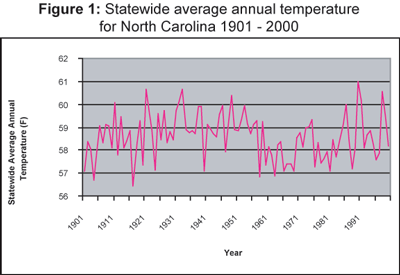See also: Weather and Climate in a Snap!; Climate and Weather Overview; Climate and Weather (from the Encyclopedia of North Carolina)

During the last few decades global warming has held the climatic headlines. The earth's atmosphere as a whole, for whatever reason, has been getting warmer, especially during the last quarter of the 20th century. North Carolina and the rest of the southeastern United States, however, have shown no distinct warming trend during the past 100 years (Figure 1). The Southeast, along with one other region, southeast China, is unique in this. There have been periods of warmer weather, periods of colder weather, but no overall change. The other major aspect of climate, precipitation, has also shown year-to-year variability but no trend in the annual total amounts. This is in line with the rest of the world. But for North Carolina the consistent annual totals mask an important change: summers have been getting drier, while falls are getting wetter. As a consequence, North Carolinians tend to have less water available for their use than they did 100 years ago.
The long-term changes are difficult to detect without careful analysis of lots of weather observations. People rarely notice them directly as they go about their everyday business. But they do notice unusual or extreme weather events. And they have had plenty of them recently. In the 5-year period between 1998 and 2002, for example, hurricanes, floods, ice storms, heat waves and droughts have all visited the state, and in one way or another affected almost all parts of it (Figure 2). It is difficult to determine whether these events are more frequent than in the past, since not only is the ability to observe the weather continually getting better, but also there are simply more of us to notice and be inconvenienced by any event. Nevertheless, an examination of the number and types of events decade by decade suggests that extreme events which cause trouble have become more frequent recently, possibly going back towards the situation last seen in the 1950s. Although our skill in predicting the weather very far into the future is extremely limited, these past conditions can serve as a rough guide that suggests that for the next decade or so troublesome events will continue to be regular visitors.

The long term trends in the climate, particularly the seasonal precipitation change, may have a major impact on people, but they do not consciously notice them or their impact. Extreme and unusual weather events are another matter. They impose themselves on life, creating at the very least some inconvenience. Throughout recorded history North Carolina has been visited by hurricanes, winter storms, tornados, floods, and similar violent events, along with more silent killers such as heat waves and droughts. The last few years have been no exception. There have been, as Figure 2 suggests, a range of spectacular events, and indeed it seems that the weather has been unusually tempestuous during this period. Is this really the case? What can it suggest about future weather and climate? Estimating the number of events which have occurred over the past century is difficult. Observations have improved over time, while the number of people in the state to see, record and be affected by them has been continually increasing. So events seem to have become more frequent as the 20th century progressed. This has been particularly the case for local events such as flash floods or tornados, but even for major features like hurricanes it is necessary to make some assumptions and estimates about their frequency. Nevertheless, the main trends are clear and they can be used to put recent series of phenomena into the long-term context of climatic variability and change.